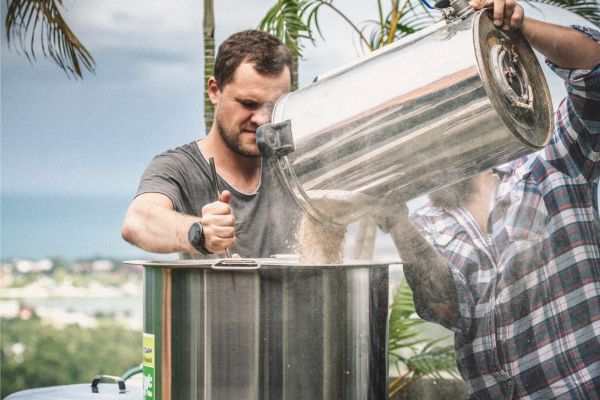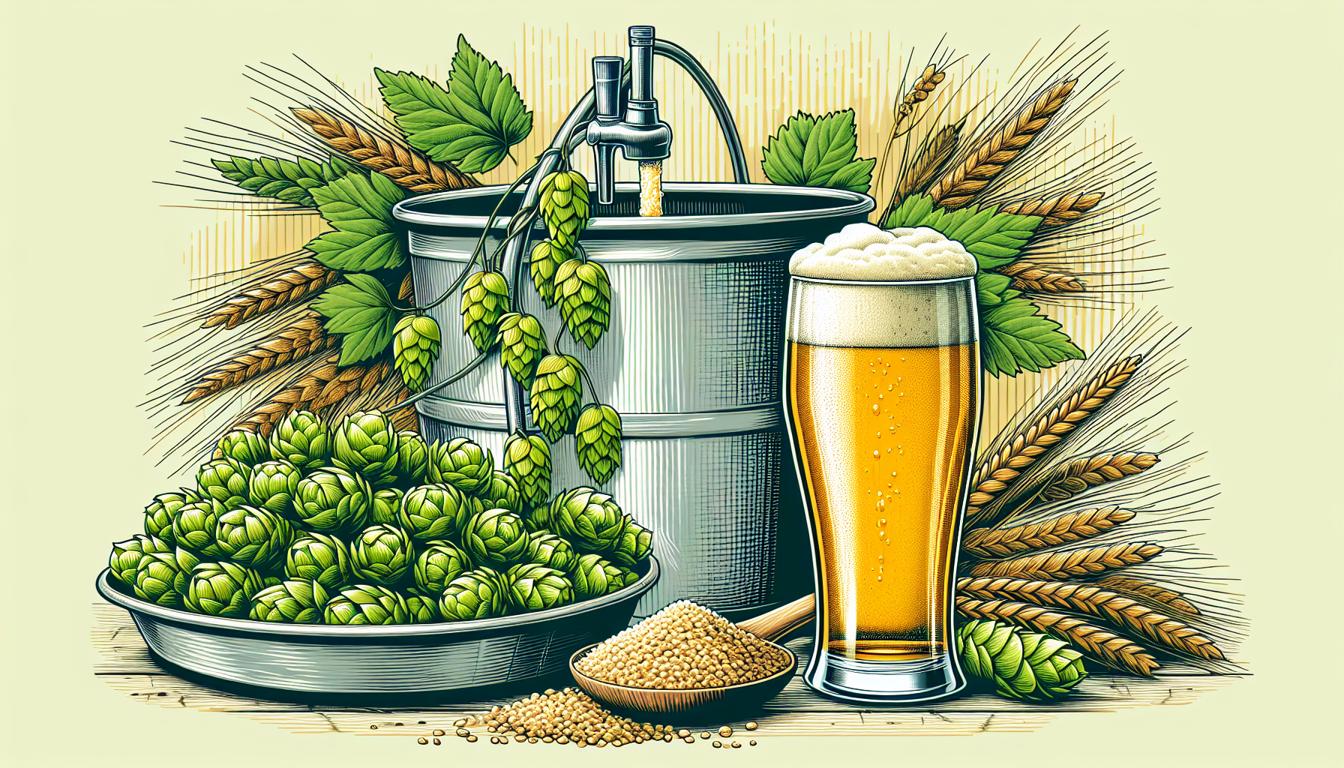How long to ferment barley wine? Barley wine is a complex and strong ale that typically requires a longer fermentation period than most other beer styles.
The fermentation time can range from 2-3 weeks for primary fermentation, followed by an extended secondary fermentation or aging period of several months to over a year.
In this blog post, I will discuss the various factors that influence the fermentation time of barley wine, share some personal experiences, and provide tips to ensure a successful fermentation process.
The brewing process
Mashing and lautering
The first step in brewing barley wine is mashing, where crushed grains are mixed with hot water to convert starches into fermentable sugars.
This process takes about 60-90 minutes, depending on the specific recipe and temperature schedule. After mashing, the sweet liquid called wort is separated from the grains through a process called lautering.
This step is critical for obtaining a high sugar concentration, which contributes to the high alcohol content in barley wine.
Boiling and hop additions
Next, the wort is boiled for a specified duration, usually around 60-90 minutes. During the boil, hops are added at various times to contribute bitterness, flavor, and aroma to the beer.

Barley wine typically has a high level of bitterness to balance the sweetness from the malt, so generous hop additions are common.
Cooling and pitching yeast
Once the boil is complete, the wort must be cooled rapidly to a temperature suitable for yeast fermentation. This is typically accomplished using a wort chiller. Once the wort is cooled, it is time to pitch the yeast. Since barley wine has a high starting gravity, it is essential to use a healthy and robust yeast strain capable of fermenting the high sugar content and producing a high alcohol content.
Primary fermentation
The primary fermentation stage is when the yeast consumes the sugars in the wort and produces alcohol and carbon dioxide.
For barley wine, primary fermentation typically takes 2-3 weeks. It is essential to maintain a consistent and appropriate temperature during this stage, as fluctuations can stress the yeast and lead to off-flavors or incomplete fermentation.
Secondary fermentation and aging
After primary fermentation is complete, it is time to transfer the beer to a secondary fermenter, such as a glass carboy or stainless steel vessel, for an extended aging period. This step is crucial for allowing the complex flavors of barley wine to develop and mature. The secondary fermentation and aging period can last anywhere from several months to over a year depending on the desired flavor profile and level of alcohol.
Monitoring fermentation progress
To ensure a successful fermentation, it is essential to monitor the progress through gravity readings and visual inspection. A hydrometer is used to measure the specific gravity of the beer, which indicates the sugar content and potential alcohol content. Regular gravity readings can help determine when primary fermentation is complete and when it is time to transfer the beer to secondary fermentation.
Factors affecting fermentation time
Several factors can influence the fermentation time of barley wine, including:
- Yeast strain: Different strains of yeast have varying alcohol tolerances and fermentation rates.
- Starting gravity: Higher gravity worts generally require longer fermentation times due to the higher sugar content.
- Fermentation temperature: Higher temperatures can speed up fermentation but may also produce off-flavors. Lower temperatures can result in a cleaner flavor profile but may extend fermentation time.
- Oxygenation: Proper oxygenation of the wort is essential for healthy yeast growth and efficient fermentation.
Tips for successful barley wine fermentation
1. Choose a robust and alcohol-tolerant yeast strain.
2. Ensure proper oxygenation of the wort before pitching yeast.
3. Maintain a consistent and appropriate fermentation temperature.
4. Monitor fermentation progress through gravity readings and visual inspection.
5. Be patient and allow for an extended secondary fermentation and aging period to develop the complex flavors characteristic of barley wine.
Conclusion
In conclusion, fermenting barley wine is a lengthy process that can take several weeks for primary fermentation and several months to over a year for secondary fermentation and aging. By understanding the factors that influence fermentation time and following the tips provided in this post, you can ensure a successful fermentation and produce a delicious and complex barley wine.
10 Facts about Barley Wine:
1. Barley wine is a strong and complex ale with a high alcohol content.
2. The fermentation time for barley wine typically ranges from 2-3 weeks for primary fermentation.
3. An extended secondary fermentation and aging period of several months to over a year is essential for developing the complex flavors of barley wine.
4. Barley wine has a high starting gravity, which requires a robust and alcohol-tolerant yeast strain.
5. Proper oxygenation of the wort is crucial for healthy yeast growth and efficient fermentation.
6. Maintaining a consistent and appropriate fermentation temperature is essential for preventing off-flavors and incomplete fermentation.
7. Monitoring fermentation progress through gravity readings and visual inspection can help determine when to transfer the beer to secondary fermentation.
8. Factors affecting fermentation time include yeast strain, starting gravity, fermentation temperature, and oxygenation.
9. Tips for successful barley wine fermentation include choosing a robust yeast strain, ensuring proper oxygenation, maintaining a consistent temperature, monitoring fermentation progress, and being patient during the aging process.
10. The extended fermentation and aging process of barley wine results in a rich, flavorful, and high-alcohol beer that is worth the wait.
FAQs
Why is my wine not fermenting after 48 hours?
There could be several reasons why your wine is not fermenting after 48 hours. Firstly, it is possible that the yeast you used is not viable or active enough to initiate fermentation. Secondly, the temperature might be too low for fermentation to occur, as yeast typically require a specific temperature range to thrive. Additionally, if the must (grape juice) lacks essential nutrients, such as nitrogen, the yeast may struggle to ferment. Lastly, excessive exposure to oxygen or the presence of certain chemicals can inhibit fermentation. It is advisable to check these factors and make necessary adjustments to promote fermentation.
Why is my wine still bubbling after 2 weeks?
If your wine is still bubbling after 2 weeks, it is likely undergoing a secondary fermentation. This can occur when residual sugars or yeast are present in the wine. Secondary fermentation can be caused by various factors such as incomplete fermentation, the addition of sugar, or the presence of wild yeast. It is important to monitor the fermentation process and ensure that the wine is properly sealed to prevent any issues.
What temperature do you ferment Barleywine?
Barleywine is typically fermented at a temperature range of 65-70°F (18-21°C). This temperature range allows for the yeast to effectively ferment the sugars in the barleywine, resulting in the desired flavors and alcohol content. It is important to maintain a consistent temperature throughout the fermentation process to ensure optimal yeast activity and a successful fermentation.
How long should homemade wine ferment?
The duration of fermentation for homemade wine can vary depending on various factors such as the type of wine being made, the yeast strain used, and the desired flavor profile. In general, primary fermentation typically lasts around 1-2 weeks, during which the yeast converts sugar into alcohol. After primary fermentation, secondary fermentation may occur, lasting anywhere from a few weeks to several months, allowing the wine to develop more complex flavors and aromas. It’s important to monitor the specific gravity and taste the wine regularly to determine when fermentation is complete.
What temperature do you mash English Barleywine?
For English Barleywine, the typical mash temperature range is around 149-154°F (65-68°C). This range allows for the enzymes in the malt to efficiently convert starches into fermentable sugars, resulting in a beer with a rich malt character and high alcohol content.
How do you know when homemade wine is done fermenting?
To determine if homemade wine is done fermenting, there are a few key indicators to observe. Firstly, check the specific gravity using a hydrometer. When the reading remains stable for several consecutive days, it suggests that fermentation is complete. Additionally, monitor the airlock activity; if there are no more bubbles or it slows down significantly, it indicates the end of fermentation. Taste the wine to ensure it has reached the desired level of dryness or sweetness. Lastly, ensure there are no residual sugars by confirming that the wine has cleared and no longer appears cloudy.




